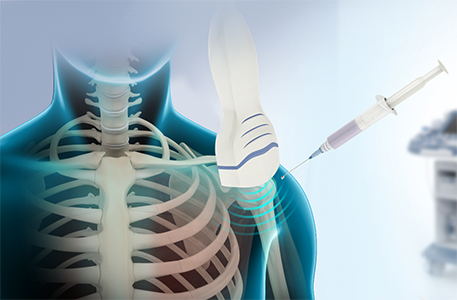
Perhaps you’ve been told you need an injection, and it will be conducted using ultrasound guidance. But what does that mean, and why does it matter?
What is Ultrasound?
Ultrasound is a diagnostic technique that uses sound waves to send images of internal body structures, such as joints, tendons, muscles, or internal organs, to a computer screen. During an ultrasound procedure, the technician applies gel to the skin of the target area. The gel provides a tight bond between the skin and the probe (also called a transducer) as the probe is passed over the target area. This tight bond is needed to ensure there is minimal interference with transmission of the sound waves. The probe transmits images of the structures under the skin to a computer screen. There is no exposure to radiation during ultrasound imaging.
Why is Ultrasound used to Guide Injections?

Ultrasound is particularly helpful when it’s necessary to target an injection into a specific area. For example, if a knee joint is being injected with a lubricant, such as hyaluronic acid, the injector wants to be sure to apply the treatment in the correct areas of the knee joint. Using ultrasound guidance for an injection allows for more accurate treatment of the affected joint and improves the chance of treatment success.
Ultrasound-guided injections are often used for both safety and accuracy. With in-clinic ultrasound, physicians can see your nerves and blood vessels and avoid them while performing your injection. Fluids can also be seen during ultrasound-guided imaging, which means the injector can see exactly where the medication is being distributed.
Ultrasound-Guided Injection: What to Expect
The entire procedure usually takes less than an hour. This includes cleaning the target site, injecting a local anesthetic to numb the site, preparing the ultrasound equipment, and administering the injection.
Side effects might include: bleeding, bruising, temporary flaring of pain, temporary rises in blood sugar, cartilage damage, and nerve damage. Be sure to discuss the possible side effects of ultrasound-guided injection with your physician before the procedure.
What about Recovery?
Recovery time varies depending on the procedure. It’s important to follow all the post-procedure instructions closely to avoid infection or other adverse reactions. It may take a couple of weeks to experience a noticeable improvement in pain. Always be sure to monitor the injection site for signs of infection. These include:
- Fever of 100.4 F or greater within 10 days of the injection
- Persistent swelling, pain, or redness at the injection site
- Drainage from the injection site

